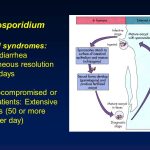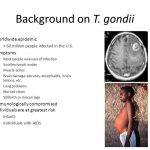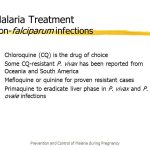
Enteric cryptosporidiosis is the most common clinical presentation in patient populations. In addition, immunocompromised patients may present with cholecystitis or respiratory infections attributed to C parvum (Box 1).

There are numerous distinct species of ameba within the genus Entamoeba, and the majority of these do not cause disease in humans. E histolytica is a pathogenic species that is capable of causing disease, such as colitis or liver abscess, in humans. E dispar is prevalent and is indistinguishable from E histolytica by conventional laboratory methods. E dispar exists in humans in only an asymptomatic carrier state and does not cause colitis.

Toxoplasma gondii infection, or toxoplasmosis, is a zoonosis (the definitive hosts are members of the cat family). The two most common routes of infection in humans are by oral ingestion of the parasite and by transplacental (congenital) transmission to the fetus. Ingestion of undercooked or raw meat that contains cysts or of water or food contaminated with oocysts results in acute infection.

Immunocompetent adults and children with toxoplasmic lymphadenitis do not require treatment unless symptoms are severe or persistent. Infections acquired by laboratory accident or transfusion of blood products are potentially more severe, and these patients should always be treated. The combination of pyrimethamine, sulfadiazine, and folinic acid for 4-6 weeks is the most commonly used and recommended drug regimen (Box 2).

Primary infection in any host often goes unrecognized. In ~ 10% of immunocompetent individuals, it causes a self-limited and nonspecific illness that rarely requires treatment. The most frequently observed clinical manifestation in this setting is lymphadenopathy and fatigue without fever; other manifestations include chorioretinitis, myocarditis, and polymyositis (Box 1). Reinfection occurs but does not appear to result in clinically apparent disease.

Patients with nonfalciparum malaria invariably develop fever and chills that may become cyclic. Initially, patients experience chills, which are followed by fever (Box 1). Patients with malaria often manifest many nonspecific symptoms such as weakness, malaise, headache, and myalgias. As the disease progresses, signs of anemia, such as pale conjunctiva, may be seen.